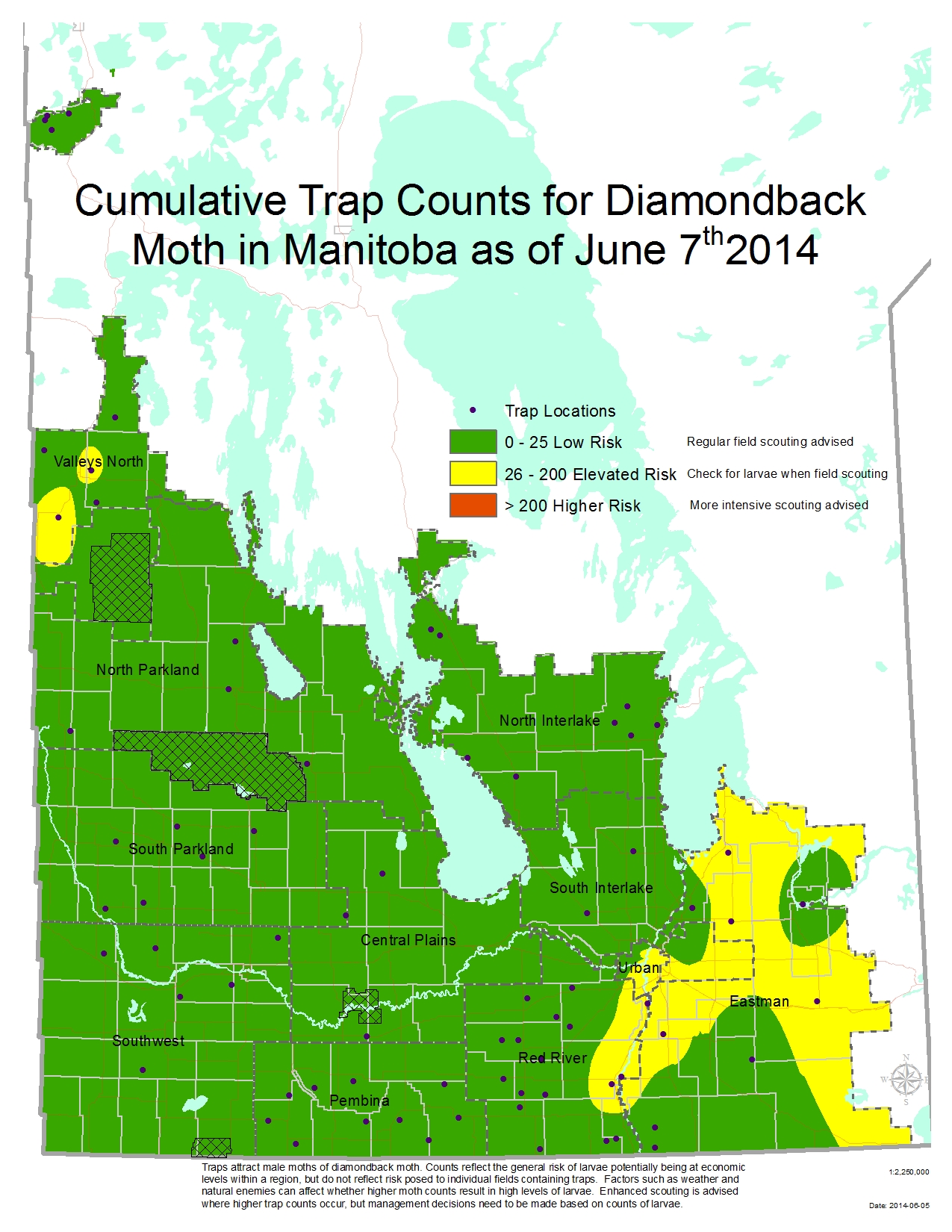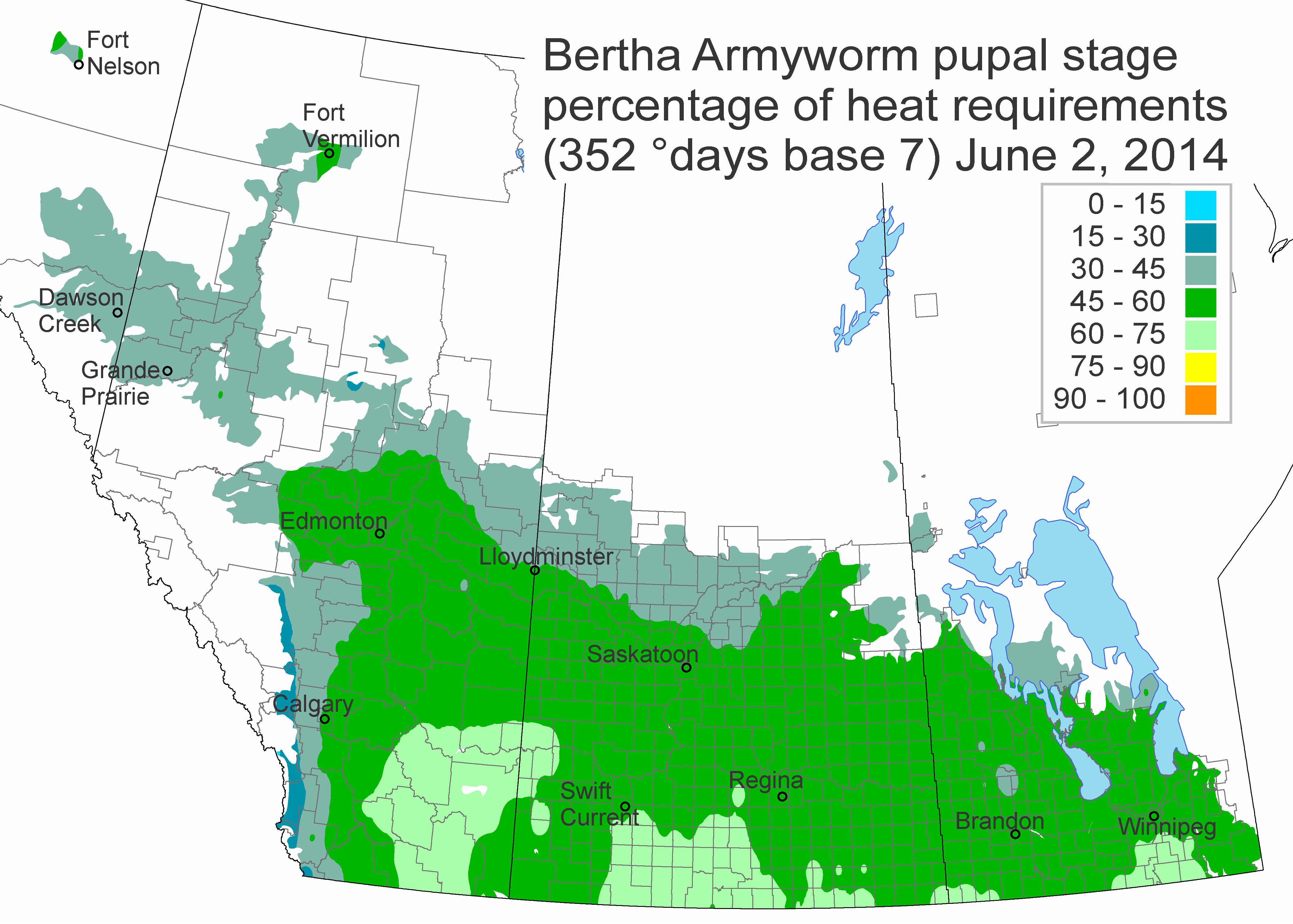Manitoba Insect and Disease Update: June 3, 2014
Compiled by:
- John Gavloski, Entomologist
Manitoba Agriculture, Food and Rural Development
Phone: (204) 745-5668
Fax: (204) 745-5690. - Vikram Bisht, Plant Pathologist
Manitoba Agriculture, Food and Rural Development
Phone: (204) 745-0260
Fax: (204) 745-5690
To report observations on insects or plant pathogens that may be of interest or importance to farmers and agronomists in Manitoba, please send messages to the above contact address.
To be placed on an E-mail list so you will be notified immediately when new Manitoba Insect and Disease Updates are posted, please contact John Gavloski at the address or numbers listed above.
To be placed on an E-mail list so you will be notified immediately when new Manitoba Insect and Disease Updates are posted, please contact John Gavloski at the address or numbers listed above.
Summary: Flea beetles in canola and cutworms are the insects of most concern currently. In some of the earlier seeded canola fields the effectiveness of the seed treatments has been reduced, and insecticides have been applied. Most of the reports of flea beetle damage and control have been from Central and Eastern Manitoba.
Flea Beetles
When does the canola become more resistant to flea beetles: In a study in Manitoba, yield was reduced most when plants were damaged during the seedling to second true leaf stage, but was not reduced when they were damaged after reaching the third to fourth true leaf stage (Bracken and Bucher. 1986. The Canadian Entomologist. 118: 319-324). So as a general guideline, once canola reaches the 3 to 4 leaf stage it can usually compensate well for feeding by flea beetles.
Estimating % defoliation. The threshold suggested for controlling flea beetles that are feeding on canola is 25% defoliation and flea beetles still actively feeding. Estimating % defoliation can be tricky, as our eyes are drawn to the damage and it is easy to overestimate how much feeding has occurred, Having a photo key as a guide can be useful for learning to assess defoliation levels. Work done at Agriculture and Agi-Food Canada in Saskatoon produced the photos in the following factsheet, which can be used to help assess levels of defoliation. Note the minor levels of feeding, such as 10% are normal and can happen even when seed treatments are still working effectively. Flea beetles need to feed to acquire insecticide in the seed treatment. These low defoliation levels will have no significant impact on the yield of canola.
Cutworm Feeding
High levels of feeding by cutworms has been noted in sunflowers in the Carman and Sanford areas, and in corn in the Starbuck area. In many fields the dingy cutworm seems to be the dominant species this year. Dingy cutworm overwinters as a partially grown larva, so is fairly large at a time when some of our other common species are still quite small. So one possible reason we may be seeing more dingy cutworms currently is that they are fairly large, making them easier to find, and doing more damage,
Some have been noting feeding belowground on stems in fields where they were finding cutworms, and wondering if this was cutworm or wireworm feeding. Some species of cutworms will feed belowground. Either cutworms or wireworms can cause feeding to the belowground part of stems.
Insecticide application tips for cutworms:
- Cutworms are nocturnal, hiding in the soil or under debris during the day, and feeding at night. Spraying late in the day or the evening is the preferred timing.
- Cutworms can be very patchy in a field. Sometimes only patches in a field need to be treated.
- Not all cutworms are killed the first evening of an application. Cutworms that are molting are not feeding and will not be killed until they resume feeding. Registered insecticides have enough residual that these will eventually be killed. So the odd live cutworm the day after an application does not necessarily mean product failure.
Insect Monitoring Programs
Diamondback moth: Diamondback moth counts have increased in some locations in eastern Manitoba and the Swan River Valley. Currently, the highest cumulative counts, from trapping in May and early-June are 98 (Stead), 55 (Morris), 46 (Morris), and 42 (St. Adolphe). Yellow on the map below indicates area where the counts are starting to increase. In these areas, make sure to look for larvae of diamondback moth while scouting fields. However, these increasing counts are of male moths, and do not necessarily mean many larvae will be present, as many factors regulate populations.

Bertha armyworm: The map below indicates at what stage the pupae of the bertha armyworm are in their development. Currently, some may have accumulated enough heat to be about 60-75% through their pupal development. Initial emergence can occur when the average pupal development is about 80%. So for those involved in putting out pheromone-baited traps for bertha armyworm, next week is a good time to get the traps out.


